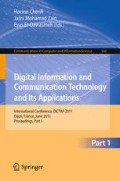Abstract
Botnets are security threat now days, since they tend to perform serious internet attacks in vast area through the compromised group of infected machines. The presence of command and control mechanism in botnet structure makes them stronger than traditional attacks. Over course of the time botnet developer have switched to more advanced mechanism to evade each of which new detection methods and countermeasures. As our knowledge , existing survey on botnets area have just focused on determining different attributes of botnet behavior, hence this paper attempts to introduce botnet with a famous bot sample for defined behavior that provides obvious view on botnets and its feature. This paper is based on our two previous accepted papers of botnets on IEEE conferences namely ICCSIT 2011 and ICNCS 2010.
Access this chapter
Tax calculation will be finalised at checkout
Purchases are for personal use only
Preview
Unable to display preview. Download preview PDF.
References
Brodsky, A., Brodsky, D.: A Distributed Content Independent Method for Spam Detection, University of Winnipeg, Winnipeg, MB, Canada, R3B 2E9, Microsoft Corporation, Redmond, WA, USA (2007)
Cole, A., Mellor, M., Noyes, D.: Botnets: The Rise of the Machines (2006)
Botnets: The New Threat Landscape, Cisco Systems solutions (2007)
Shirley, B., Mano, C.D.: Sub-Botnet Coordination Using Tokens in a Switched Network. Department of Computer Science Utah State University, Logan, Utah (2008)
Davis, C.R., Fernandez, J.M., Neville, S., McHugh, J.: Sybil attacks as a mitigation strategy against the Storm botnet, École Polytechnique de Montréal, University of Victoria, Dalhousie University (2008)
Li, C., Jiang, W., Zou, X.: Botnet: Survey and Case Study, National Computer network Emergency Response technical, Research Center of Computer Network and Information Security Technology Harbin Institute of Technology, China (2010)
Dagon, D., Gu, G., Lee, C.P., Lee, W.: A Taxonomy of Botnet Structures. Georgia Institute of Technology, USA (2008)
Dittrich, D., Dietrich, S.: Discovery techniques for P2P botnets, Applied Physics Laboratory University of Washington (2008)
Dittrich, D., Dietrich, S.: P2P as botnet command and control: a deeper insight. Applied Physics Laboratory University of Washington, Computer Science Department Stevens Institute of Technology (2008)
Stinson, E., Mitchell, J.C.: Characterizing Bots’ Remote Control Behavior, Department of Computer Science. Stanford University, Stanford (2008)
Cooke, E., Jahanian, F., McPherson, D.: The Zombie Roundup: Understanding, Detecting, and Disrupting Botnets. Electrical Engineering and Computer Science Department University of Michigan (2005)
Naseem, F., Shafqat, M., Sabir, U., Shahzad, A.: A Survey of Botnet Technology and Detection, Department of Computer Engineering University of Engineering and Technology, Taxila, Pakistan 47040. International Journal of Video & Image Processing and Network Security IJVIPNS-IJENS 10(01) (2010)
Gu, G., Zhang, J., Lee, W.: BotSniffer: Detecting Botnet Command and Control Channels in Network Traffic, School of Computer Science, College of Computing Georgia Institute of Technology Atlanta, GA (2008)
Milletary, J.: Technical Trends in Phishing Attacks, US-CERT (2005)
Nazario, J.: BlackEnergy DDoS Bot Analysis, Arbor Networks (October 2007)
McLaughlin, L.: Bot Software Spreads, Causes New Worries. IEEE Distributed Systems Online 1541-4922 © (2004)
Daswani, N., Stoppelman, M.: the Google Click Quality and Security Teams, The Anatomy of Clickbot.A, Google, Inc. (2007)
Provos, N., Holz, T.: Virtual honeypot: tracking botnet (2007)
Ianelli, N., Hackworth, A.: Botnets as a Vehicle for Online Crime, CERT/Coordination Center (2005)
Yegneswaran, P.B.V.: An Inside Look at Botnets, Computer Sciences Department University of Wisconsin, Madison (2007)
Royal, P.: On the Kraken and Bobax Botnets, DAMBALLA (April 9, 2008)
Wang, P., Aslam, B., Zou, C.C.: Peer-to-Peer Botnets: The Next Generation of Botnet Attacks. School of Electrical Engineering and Computer Science. University of Central Florida, Orlando (2010)
Wang, P., Wu, L., Aslam, B., Zou, C.C.: A Systematic Study on Peer-to-Peer Botnets. School of Electrical Engineering & Computer Science University of Central Florida Orlando, Florida 32816, USA (2009)
Mitchell, S.P., Linden, J.: Click Fraud: what is it and how do we make it go away, Thinkpartnership (2006)
Mori, T., Esquivel, H., Akella, A., Shimoda, A., Goto, S.: Understanding Large-Scale Spamming Botnets From Internet Edge Sites, NTT Laboratories 3-9-11 Midoricho Musashino Tokyo, Japan 180-8585, UW – Madison 1210 W. Dayton St. Madison, WI 53706-1685, Waseda University 3-4-1 Ohkubo, Shinjuku Tokyo, Japan (2010)
Holz, T., Steiner, M., Dahl, F., Biersack, E., Freiling, F.: Measurements and Mitigation of Peer-to-Peer-based Botnets: A Case Study on StormWorm, University of Mannheim, Institut Eur´ecom, Sophia Antipolis (2008)
Holz, T.: Spying with bots, Laboratory for Dependable Distributed Systems at RWTH Aachen University (2005)
Lu, W., Tavallaee, M., Ghorbani, A.A.: Automatic Discovery of Botnet Communities on Large-Scale Communication Networks, University of New Brunswick, Fredericton, NB E3B 5A3, Canada (2009)
Zhu, Z., Lu, G., Chen, Y., Fu, Z.J., Roberts, P., Han, K.: Botnet Research Survey, Northwestern Univ., Evanston, IL (2008)
Zhu, Z., Lu, G., Fu, Z.J., Roberts, P., Han, K., Chen, Y.: Botnet Research Survey, Northwestern University, Tsinghua University (2008)
Li, Z., Hu, J., Hu, Z., Wang, B., Tang, L., Yi, X.: Measuring the botnet using the second character of bots, School of computer science and technology, Huazhong University of Science and Technology, Wuhan, China (2010)
Author information
Authors and Affiliations
Editor information
Editors and Affiliations
Rights and permissions
Copyright information
© 2011 Springer-Verlag Berlin Heidelberg
About this paper
Cite this paper
Lashkari, A.H., Ghalebandi, S.G., Reza Moradhaseli, M. (2011). A Wide Survey on Botnet. In: Cherifi, H., Zain, J.M., El-Qawasmeh, E. (eds) Digital Information and Communication Technology and Its Applications. DICTAP 2011. Communications in Computer and Information Science, vol 166. Springer, Berlin, Heidelberg. https://doi.org/10.1007/978-3-642-21984-9_38
Download citation
DOI: https://doi.org/10.1007/978-3-642-21984-9_38
Publisher Name: Springer, Berlin, Heidelberg
Print ISBN: 978-3-642-21983-2
Online ISBN: 978-3-642-21984-9
eBook Packages: Computer ScienceComputer Science (R0)

